I arrived into Lima’s Jorge Chavez International Airport on Friday June 5th, after a personal trip to Cuzco and Machu Picchu. I had come to Peru for a 5-day Indigenous summit in the southern Peruvian Andes and decided to take a few days off at the end to see these world-renowned sights, thinking I may not have the chance again. At the summit, we had been informed there of the situation on the ground in the Amazon. Alberto Pizango, president of the organization AIDESEP, the Inter-ethnic Association for the Development of the Peruvian Amazon, which represents 400,000 Indigenous Peoples of the Amazon, had even come to the summit to speak. So on Friday, waiting for my plane back to Canada, I was alarmed to hear of the crisis unfolding in the Amazon, but felt remorseful that I would be leaving now, in the moment of crisis. That is, until the security guard came looking for me to inform me that my flight had been cancelled. Suddenly, I was free. They let me book another return ticket to Ottawa, so I had them give me a week more in Peru.

Alberto Pizango, Center, May 31st
The next day, I headed into the offices of AIDESEP, urged on by a friend from the Ecuadorian Amazon who said they could use help. Immediately I was put to work in the communications office, helping translate, taking photos and audio of the press conference that morning, and looking into international press and assistence. When I finally had the chance to meet with the acting director, Pizango having already gone into hiding after a warrant was issued for his arrest, he offered me the opportunity of a lifetime. I was to head into the Amazon itself with a delegation from AIDESEP, one of their lawyers, and some press. They needed a delegation from their central offices in Lima to talk with the people, take pictures and collect information, and I jumped at the opportunity.
That’s how a week later I ended up in Jaen, an hour outside the town of Bagua, where the tragic events of June 5th were centered. On Monday, June 8th I returned to the office, which was in turmoil, and it took hours before anyone had enough free time to chat. I posted an article I had written online, and worked to get it distributed far and wide, being one of the few English language articles at the time to go in-depth about the events here. I had another meeting with some AIDESEP leaders, and they told me that the next day I was to head to the Amazon area to assist. It was settled.
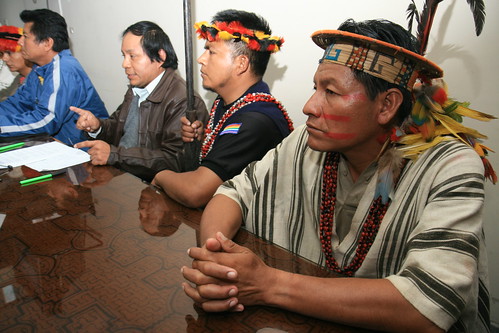
AIDESEP Press Conference, Lima, June 6th
The next day I came back once again to the office, and spent the day working again, responding to many emails and a number of interview requests. Later that night, we boarded a plane to Chiclayo, the closest town to the events, the lawyer not making it due to miscommunication, but picking up two journalists, a photographer and a documentary maker along the way. Arriving at the airport, we caught a 5 hour ride to Jaen, since we couldn’t directly enter Bagua, which was under military curfew. The next day, we travelled immediately to Bagua to begin reconstructing the events.
Here’s the official story, up to that point: starting 55 days prior, Amazon groups had begun a Regional Strike, shutting down a number of transportation routes and oil facilities. The strike had been peaceful, the demands being the retraction of a series of laws that were passed that would open large swaths of the Amazon to foreign companies, including oil, mining, logging and agricultural interests, which Indigenous groups feared would ruin the environment irrevocably and threaten their very future. They asserted the laws would open up about 70% of the Amazon to foreign companies. Moreover, the process of arriving at these laws was a violation of ILO Convention 169 and the UN Declaration on the Rights of Indigenous Peoples, which say Indigenous groups have the right to be involved in any decision making which affects them, and have the right to free, prior and informed consultation over any projects in their territories.

The Devil’s Curve, June 5th – Photo: Thomas Quirynen
On June 5th, minutes before 6am, police were given the order to remove protestors from a stretch of road known as the Devil’s Curve, where a few thousand Indigenous people had gathered for weeks. Suddenly, the approach turned from conversation to confrontation. A few hundred police had decided to descend from the hills overlooking the highway, provoking surprise and interest from the Native groups, who weren’t expecting the police at all. They went up to talk and plead against violence, but words failed, and according to many who were present at the incident, the police began to shoot at the Natives. This provoked a few responses – many chose to flee, returning down the mountain, while others took this as a call to war, and climbed up, the Awajún and Wambi being renowned as warrior nations. Armed with only spears, they tried to defend themselves, but many fell before the automatic weaponry of the police’s special forces. In the fog of war, nobody can say exactly how many were lost, but we do know over a hundred were wounded.
Soon after, at least one helicopter seems to have shown up over the horizon, according to different accounts, shooting tear gas, bullets, and/or incendiary bombs. Many were fleeing at this point, and ambulances and private vehicles began to take away a number of the victims to the nearest town, Bagua Chica, a few kilometres down the road. At some point, a number of armoured vehicles (referred to as tanks by locals) of the DIROES – police special forces – began to come down the road, unloading more police outfitted for war. The attack continued with more teargas and bullets raining down on protestors, who began to retreat, under cover of the partial fog of teargas and some fires that had been lit on the road. Eventually the protestors were forced away from the Devil’s curve, and proceeded back to a split in the highway kilometres away, only hours later. Police continued the assault until nearly all the protestors had fled the area. This was the end of the major clashes on the highway, leaving many Native protestors dead and wounded on both sides, but marked the beginning of many unanswered questions.

El Reposo, between the Devil’s Curve and Bagua – Photo: Thomas Quirynen
In Bagua, the town in closest proximity, an incredible turn of events brought about a number more dead and wounded among the civilian population. Shortly after the police began their operation, the casualties of the battle unfolding began to reach the hospital in Bagua. The reaction amongst the citizens of Bagua – a predominately Mestizo/non-Indigenous town – was telling. Reacting in indignation, solidarity, outrage, perhaps even fear, the townspeople revolted. Many gathered -unarmed – in the Plaza de Armas, the main square that touches on the municipal building, the church, and the police commission. By 8am, the town itself had turned riotous, throngs of angry protestors massed outside the police building, wanting justice, wanting to make sure the events transpiring minutes out of town didn’t repeat themselves. At this point, the aim seemed to be to not allow more reinforcements into the town from the highway, or onto the highway from town.
Regardless, the police response sealed the fate of a number of protestors. As numbers swelled outside, rocks shattered the glass and the calm of the town. Police ascended to the rooftop of their concrete building, and began firing upon the crowd. Not only teargas, but live bullets dispersed much of the crowd. The worst was over within a few short hours, leaving a few dead, and many more wounded, taken to the hospital nearby. Among those mortally wounded was Felipe Sabio, 30, an Indigenous leader from Wawas, an Amazon community a few hours way. In total, there would be at least 10 civilians – with the true number being potentially much higher – and 24 police dead as a result of this day of indiscriminate violence that seemed to accomplish so little.
This much, we thought we knew going in. We would have to return to ground zero to unearth the real story.
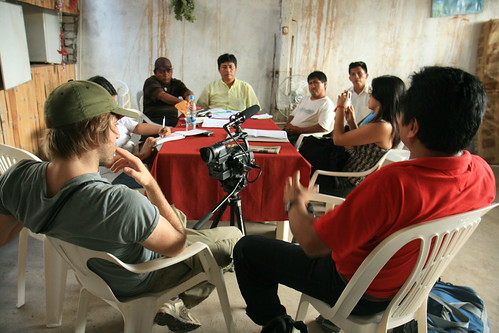
Meeting with ORPIAN and AIDESEP officials
Arriving the morning of Wednesday, July 10th, we met with Leandro Calmo, Vice President of ORPIAN, Regional Organization of Indigenous Peoples of the North Amazon. He explained to us that the official figure of only 9 deaths on the civilian side was too low. The Apus, the leaders/elders of the communities, had reported that many people failed to return from the protests. Many communities, of course, were a good distance from this area – four or five days journey, for some, so people would be just returning now to their communities, and there were over 300 communities that took part, so just amassing the information would be its own challenge.
Adding to this, Leandro related, there were witness reports coming in that helicopters had landed in the area to take away bodies, and that bodies had even been thrown into the rivers. Confounding the situation were the military, who for five days following the incident had prohibited all access to the area, even by the district attorney and local municipal officials who were conducting their own investigation. They just wanted to find their relatives, he said, so that they can return them to their communities. That was their only desire, at this point.
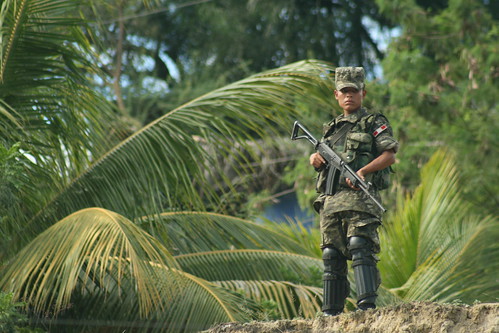
Soldier keeps curfew in Bagua
Another leader from ORPIAN, Edwin Montenegro Davila, also shared his version of the events from that day. He said at about 5:30 am is when they noticed people descending the mountain, and many of the protestors went to investigate, not suspecting police. They were surrounded. They tried to talk to police – asked them not to shoot, but the yelling started immediately, and the bullets soon after. Two of his compatriots were shot immediately. People made a hastened retreat under cover of spears and rocks. He went back to recover a fallen comrade, but was told by police to leave the man, or he would be shot as well.
We asked about the reason for the protest. On this point, nearly all answers we received were identical. People had left their communities, made the journey, and camped out, surviving off little more than yucca and bananas, for one simple reason. They wanted to protect their forest. “The forest is our supermarket, the forest is our store, the forest is our pharmacy,” related Edwin. They weren’t against development, they said, but want a better alternative. Were they the savages? No, they replied; look at how the states waste resources. They were proper scientists, who protected the forest, who protected humanity against climate change. This was the message they wanted to share with the world.

Dr. Bautista with tear gas
The call came in that local officials had been granted access to the area that morning, and had just completed their initial ground search. We hired a van to bring us out to the site. There we met up with Héctor Requejo, mayor of the province of Condorcanqui and the President of the Regional Grouping of District Attorneys, Dr. Oswaldo Bautista, who told us what they had been able to come up with, after a semi-exhaustive search. The result – very little. Remnants of the confrontation, mostly, some bullet casings and spent tear gas canisters, but it looked as if most everything else had been cleaned up.
They had received reports of 20 people total being killed as well in the battle, and heard reports of bodies thrown in the river, but not been able to find any evidence. The most we could get from them was an admission that it was suspicious that police would restrict access to the zone until almost a week later. This was it – the centre of the conflict, the only signs it had taken place were spent ammunition and a burned mountainside, which had gone up in flames during and after the battle, raising speculation in turn.
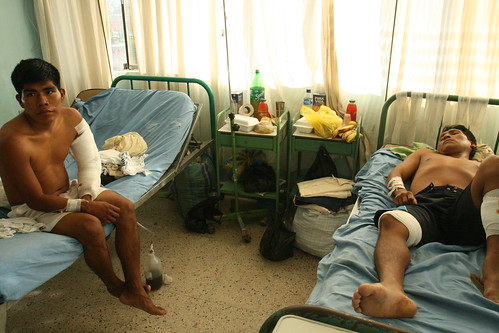
Bagua Hospital – Paul, left, and Roger
Little answers there, so instead we headed over to the hospital to see if people there knew more, had seen more. Already, most of the protestors had left the area for their communities, so the few Indigenous protestors who were left were mostly in the hospitals or the jails. We first met up with Paul Ukuncham Pascual, of Orocruz, of 22 years of age, who actually belonged to the military, as was not uncommon we found out. He had been among the first up the hill before police opened fire, he said, before being shot in the arm and side.
Roger Petsa Najantai, of Rio Santiago, 30 years old, had a similar encounter which left him with two shots to the leg, to be taken away by ambulance. Another young man by the name of Paulo Bitiap Lopez, 24, from the Shughung Community in Chiriaco had been shot from above, with the bullet entering his shoulder and exiting his side. He had traveled a week from his community to arrive, and had been there for 58 days at that point, his stated intention to protect the land. He lamented that the same Peruvian peoples were killing each other, when all they wanted was a peaceful solution.

Daniel being given water by his wife
Lastly, as many had already left the hospital, we ran into Daniel Torres Nanai, who hadn’t been shot in the violence on the highway, but rather in Bagua, the town itself. At 8:30am he had been two blocks from the plaza, when the people decided to rise up, knowing of all the deaths, he related. There was talk of taking the police commission, but instead the police got on their roof and fired live rounds into the crowd, at which point he was shot, in the right shoulder and in the stomach. He considered this whole affair to be a crime by the government, who reacted violently against Natives with a just claim, and who had not supported him in any way, though he had to pay for expensive surgery and medical care. Then, on our way out, a woman accosted us to demand that we be aware of the situation in the jails, where there were 12 detained in Bagua alone, and families were not being allowed to visit or even supplement their measly diet with bread.
Unfortunately our time did not allow us the liberty to also visit the jail – Bagua was still under military-imposed curfew, and we had to leave town to return to Jaen. The next morning we had a fortunate encounter with Nicanor Alvarado of the Vicariato del Medio Ambiente in Jaén, a church official who had been supporting the protests. His version of the events also matched that told by protestors, and he added that he had seen two protestors beaten badly, he suspected to death, hours after the main violence, when he had returned to look for victims.
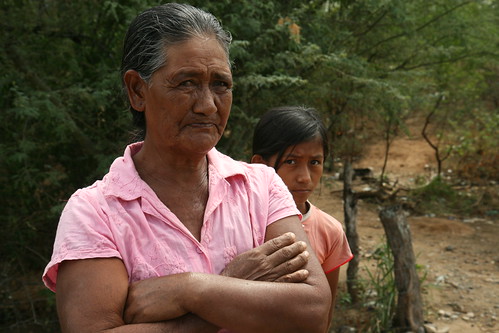
Family living on Devil’s Curve
We then had the opportunity to meet with the Defensoria del Pueblo, the “People’s Defender,” Dr. Roberto Guevara Granda. He provided the most exhaustive information to date on what had happened to many of the victims of the violence. The bodies of the deceased had been returned in days prior, and included one unidentified man who had been taken by his community. According to his account as well, the day before the confrontation had been the first attempt to remove the protestors, but many people from Bagua had arrived to support the protestors. Defeated, the police retreated, only to return a matter of hours later with greater force.
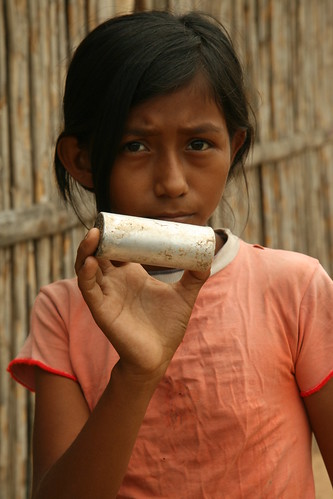
Marilu, 10, with spent munitions found in her backyard
After meeting these officials, we had the chance to catch up with a group of Indigenous leaders from ORPIAN and AIDESEP who had decided to climb the hills surrounding the Devil’s Pass themselves, to see if they couldn’t find any evidence. First though, we ran into a family whose backyard was the scene of much of the violence. The grandmother told us how the police had come to their house after the main confrontation had subsided, to look for hiding Natives. They had put their gun to the chest of her 10 year old granddaughter, Marilu, threatening them to reveal the whereabouts of anyone they were hiding. Eventually satisfied they weren’t hiding anyone, one of the special forces asked his superior if he should kill them all, while leaving. “No,” was the simple response that saved their lives. Later Marilu showed us the spent tear gas canister and Amazon spear that she had found.
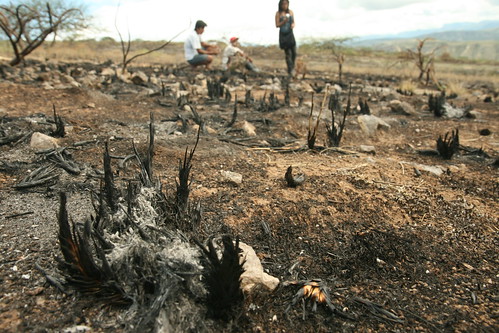
Charred remains of the hills surrounding Devil’s Curve
The search by Indigenous leaders proved less fruitful, however, and not a trace was found. The only reminder that there had been a tragic battle fought was the large swaths of vegetation which had been burnt that day during or after the battle. This didn’t settle speculation that the police may have interfered with the evidence, but instead raised more questions about the exact status of those missing. Few were left who had been at the battle, and of them, no one seemed to know the unreported victims, they only knew of their existence. There were few answers to be found in Bagua. We would have to travel into the jungle to figure out what had happened.
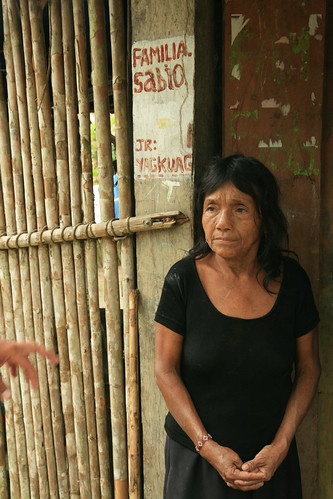
Andrea Rocca Vishu, mother of Felipe Sabio Cesar, outside Sabio family home
The next day we headed out and made our first stop a few hours away in the community of Wawas. Getting out of the car, we crossed the river in a dugout canoe and proceeded into the village. Immediately we were met by Andrea Rocca Vishu, mother of Felipe Sabio Cesar, who was shot and killed in the violence within Bagua. She was crying, dressed in black, muttering “my son, my son, they’ve shot my son.” She brought us into Felipe’s house, where we met his wife Violeta Pitug Wanpush and four children – the youngest of which had been born days before, after Felipe’s passing. Felipe had been in Bagua for over a month, the time since his wife last saw him.
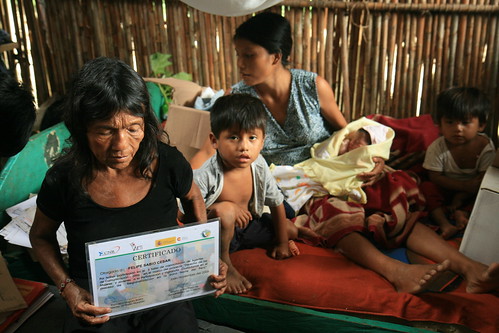
Violeta Pitug Wanpush, wife of Felipe Sabio Cesar, seen holding her newborn
She was visibly shaken, and repeated to us that “Felipe was no ordinary man, that’s why I’m so upset.” He had been a community leader, always outspoken yet humble, who had worked for the community radio and helped translate for the community when he wasn’t tending his fields or writing. “How can they think we’re terrorists, when we live like this,” Violeta said, pointing to her humble single-room home made of bamboo. “My children cry all day and ask ‘where is my daddy?’ – how am I going to take care of them without my husband?”

Gramaniel César Yancua, 26, shot through the pelvis
Community leaders brought us to meet with others who had been wounded in the confrontation. First was Gramaniel César Yancua, 26 years old. He told us how there were about 50 people who had gone up from Wawas to the Devil’s curve outside Bagua. He had been shot in the pelvis, saying that police hadn’t come to converse, but to attack. He added that many others were hurt, but had been left there. Román Jintash Shug, 44, had also been in the Devil’s curve that morning, and had been shot in the testicles as a result. He said the police arrived as if in civil war, that there was nowhere to go once they started shooting. He had managed to escape into the mountains, later taken by some friends to Bagua Grande for medical treatment. “Garcia gave the orders. The police deaths gave them power, made them gain out of the incident, while the Natives just stay dead,” he left with us.

Family member holds up photo of David Juasito Mashigkash, deceased
A few hours down the road, we arrived in the community of La Curva, home to David Jausito Mashigkash, 19 years old, who had also lost his life to the violence of Devil’s Curve. David’s father, Moises Jaucito Lucinda showed us a picture of his son, saying they had no idea they would kill him. David had lived since he was 11 outside of the community to attend school, and had recently returned to the area to study nursing. The family brought us to see the graveyard, his cousin Lucio Rocca Autuki sharing many of the last moments of David’s life. The morning the shooting started, David wanted to ascend the mountain a bit to see what was going. His cousin lost sight of him, and only found out he was dead when a photographer was showing his pictures of the deceased. Lucio felt betrayed by the government – they were getting ready to pack up and take down the barricade, that was the agreement reached the night before with the military, he affirmed.
This version of events was affirmed substantively by the version narrated by Salomón Aguanash, President of the Regional Committee for the Struggle for the Respect of Indigenous Peoples’ Rights, who we caught up with in Nazareth. Salomón had been in charge of Indigenous operations in the Devil’s Curve area, and proved to be a wealth of information. He was able to give some sense of the scale of the movement, informing us that there were about 3,600 people that had come out to the Devil’s Curve blockade, 1,900 at Station 6 (an oil facility) and a further 6,500 at Station 5.
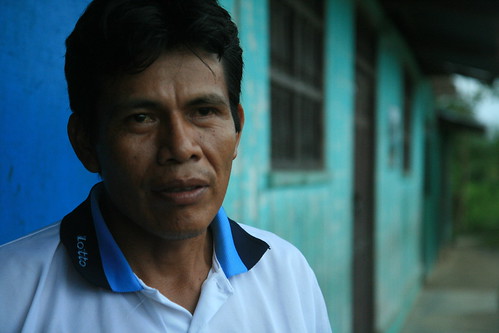
Salomón Aguanash
Discussing the meeting that took place the day before the removal of protestors, Salomón told us that the first meeting was planned for about the early afternoon and was to involve General Uribe, the regional police chief. In the end about 6,000 people showed up at this meeting, sans the general. This meeting included thousands from Bagua who showed up to express their support for the Indigenous cause. Out of that meeting, a smaller group of 9 representatives was formed who would meet with the general. In the meeting, it emerged that the general had already received the word to clear out protestors. Anxious to avoid a serious confrontation, the protestors asked to have a truce until 10am so they could clear themselves out. To this, both sides agreed.
Then, minutes before 6am the next day, the police came. According to Salomón, they came over the tops of the hills and ignored pleas against violence – and that’s when the shooting started. After Indigenous protestors witnessed two of their own fall to the ground, many reacted by throwing their spears angrily, while others took the opportunity to flee. Salomón testified that it was within 15 minutes of the police arrival, the helicopters showed up, firing live ammunition, tear gas, and somehow setting fire to the hills, perhaps with the tear gas or incendiary munitions. “Tanks” (armoured personnel carriers) arrived now from the road, also shooting at protestors. “If they wanted us to leave, why didn’t they come from the road at the beginning? The order was to kill us,” claimed Salomón.

Military forces keep an uneasy calm over Bagua
As to the numbers who didn’t return, Salomón also noted discrepancies with the official numbers. Having talked to members of Santiago, Nieva and Cenepa communities, they were aware of at least 85 people who hadn’t returned from the protests, and another two from Tutongos. Community leaders would be getting together to figure out final numbers of missing. He also identified one more deceased, Jesús Carlos Timias ofUracuza, whose name didn’t appear in official lists, which would make the official list include at least 6 Natives and 5 non-Natives.
“We do not accept the kind of ‘development’ that the president offers us, because it is not sustainable and it threatens the Amazon rainforest, which is humanity’s heritage. For that reason, if the government insists on sidelining us and continues to refuse to overturn the decrees, we will no longer block roads but will instead draw our own limits to establish how far into our territories we will allow the authorities to come. Our territory is our market, our mother. We don’t have supermarkets like people in the big cities. We have to track and hunt down animals for two or three days, and find our food in the jungle. Everything we need for our survival is in the rainforest. That’s why we are defending it with our lives. The struggle will continue until the laws are gone. We’ll shut down oil extraction, and stop cooperating. What happens next is up to the government”
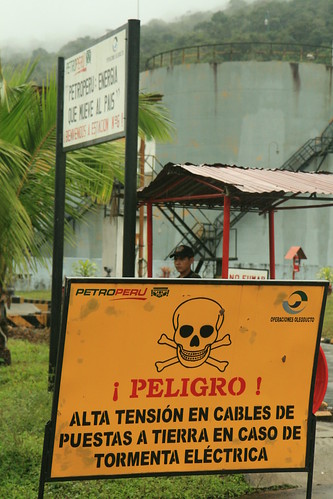
Station 6 oil facility
The next day, on our way out of the jungle, we made a stop at Station 6, oil facility taken over by Amazon groups were a number of police officers loss their lives also on June 5th. There were a number of military checkpoints set up to get to that site, and they almost didn’t let us in. In the end, we made it, and though we couldn’t get inside, we managed to talk briefly with an engineer before he decided against it. The military then decided we couldn’t even take pictures of the facility, and wouldn’t cooperate with any information, so we left.
On our way out of the jungle, passing by Wawas later that day, we chanced upon some thick oil collecting in a pool of muddy water on the side of the road. Following the source led us up a steep ravine, at the top of which we found a few dozen people gathered, working to repair an oil pipeline that appeared to be leaking. Men were hunched over, cutting down oil-covered vegetation and putting it into garbage bags, others scooping up the oil slicks into barrels from atop fresh rain-fed pools. Another crew hastily worked on the pipeline itself, while a group of Indigenous people from a local community had gathered to see what had happened to their land.

Oil pipeline leaks into the Amazon
Our very presence, replete with cameras, seemed to be menacing to the company security guard who was stationed there, who quickly called over the military. We got some photos and some “no comments” from officials, before backtracking down the muddy slope. Military reinforcements soon arrived, telling us it was illegal to take photos here, probably conflating legality with a uniform. We acquiesced, talking to a number of the locals who were concerned that the oil would leak into the river, and contaminate the environment, the waters they drink and the fish they consumed.
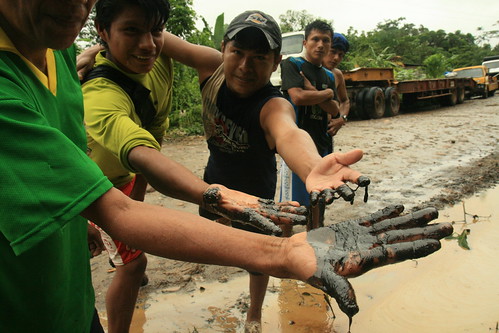
Local Indigenous residents find oil spill
In the end, it was this sort of archetypal incident that people feared and that brought thousands of communities together to reject the government’s development model for the Amazon. In our trip to the Amazon, we had sought to uncover new information. Much of what we heard hadn’t been reported, especially not internationally. However the trip revealed just as many questions as it answered, particularly the number and fate of those who participated in the confrontation early in the morning of June 5th, and who haven’t been seen since. The stories tell the reality, the faces, and the sentiments behind a sensational incident that drew world attention, but express the need for a detailed understanding of the Amazon peoples, their way of life and their demands, if we are to avoid such senseless bloodshed and misery again.
You can see more photos here.



